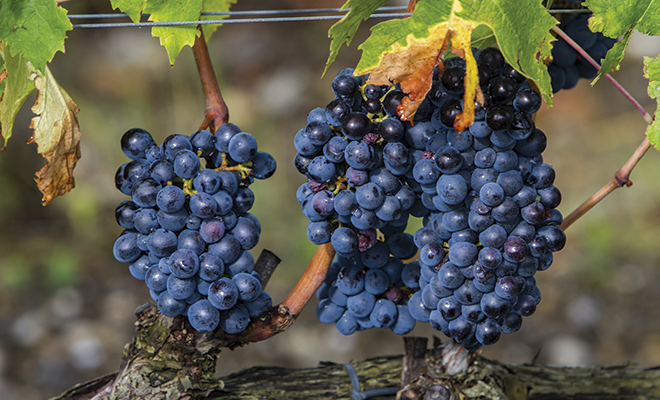
Exploring Sangiovese
The warm days of early May often give us a natural transition into thinking about summer activities, including menus and great food-friendly wines. During the cold weather, we enjoy the hearty cabernets and syrahs, but our preferences naturally change with the seasons, and it’s time to look ahead to some lighter fare. This Italian beauty may do just the trick!
Sangiovese (san-jo-VAY-zay) is indeed your Italian sweetheart. As a 16th century classic Italian grape varietal, sangiovese is the most common and most famous, often the main component in brunello, Chianti and super Tuscan blends. If you’re thinking of soft loamy earth with a touch of sour cherries and strawberry fragrance, then you’ve got sangiovese captured very well.
Interestingly, what makes this lovely varietal so easy to enjoy is often its downfall and the general dismissal as a great wine: lower alcohol. This delicate wine has the ability to not overpower your plate or your palate with too much alcohol; this can affect how you enjoy the components of your menu, from salads and fish to pastas, cheeses and savory mushroom or truffle appetizers. Believe it or not, your Friday night movie at home could easily include snacks of cheddar popcorn or grilled peanut butter sandwiches paired with your 2015 or 2016 vintage of Sangiovese.
You may have wrinkled your nose at the earlier mention of Chianti, but modern sangiovese has come a long way since the early Italian restaurant days when the only wine offered came from the rattan-covered, bottom-heavy bottles of Chianti. Because young sangiovese can be a tad acidic on its own, you’ll often find it blended with barbera, merlot, cabernet sauvignon, petit verdot and malbec, to name a few.
Because this wine plays well with others, the structure in sangiovese is a good blending partner with wines that can be higher in alcohol and lower in acid, lending to a nicely structured, balanced blend that is both easy to enjoy and has a greater ability to sit in the wine cellar. The higher the tannic level in the blend, the more likely your sangiovese can sit and age nicely. My general rule for sangiovese under $25 is to enjoy within 12 months of purchase. Higher-end blends can easily cellar for three to ten years depending on the vintage and region of origin.
Three major sangiovese blends are Chianti, Brunello di Montalcino and vino nobile di Montepulciano. You will find both imported and domestic sangiovese at your wine retailer. Sangiovese has been thriving in warmer regions of Napa, Sierra Foothills, Sonoma, San Luis Obispo, Santa Barbara as well as the Yakima Valley of Washington State for about 25 years. Although also thriving internationally in Argentina, Brazil and Chile, our domestic sangiovese blends tend to have a bit more heft, with more body and structure than the imported and traditional Chianti blends.
Do you enjoy Bordeaux? The French introduced us to the beautifully balanced Bordeaux-styled wine with merlot, cabernet franc, malbec and petit verdot added to a base of 60 percent cabernet sauvignon or merlot as primary grape. France is not alone in creating significant and sought-after blends. Italy leaves its mark in fine European wine blends with the beautiful Super Tuscan, a blend of sangiovese and cabernet sauvignon or syrah; it delightfully exhibits ripe, dark fruit balanced with soft tannins and light oak in a beautiful full-bodied wine. Traditionally, only 15 percent can be cabernet sauvignon and the sangiovese is simply getting support from the blending yet maintains the majority of the bottle. On your next wine adventure, seek out this Italian gem that benefits from its Sangiovese heritage.
When I have the opportunity to share sangiovese with folks who may be unfamiliar, I hear, “I usually prefer lighter red wines such as pinot.” I respond that they are in for a delicate surprise! Because sangiovese is lighter in body than many mainstream red wines and blends, this Italian option offers a soft mouth feel with a possible vanilla or strawberry note. It’s perfect for that appetizer course with friends and an alternative to the familiar French varietals such as merlot and pinot noir.
Personally, I can’t seem to keep sangiovese in the house. I often refer to it as the “honest wine;” because it’s not too forceful like a bold cabernet sauvignon or zinfandel can be, it’s perfect for picnics or the last-minute invite next door. I can take it to a party knowing it will go well with the menu and surprise people. Sangiovese is one of those wine friends that can handle itself in culinary situations without offending anyone.
Maybe we could all benefit from a little sangiovese, perhaps with lightly sauced pizzas, garlic and olive hummus or a Sunday afternoon charcuterie platter while we await our summer weather! ■
Sources: sfgate.com snooth.com and vinepair.com.







